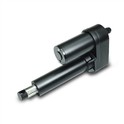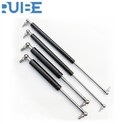When it comes to outfitting your tool box with gas struts, ensuring compatibility is crucial for both functionality and safety. As a dedicated supplier of gas struts for tool boxes, I understand the challenges that customers face in determining whether the gas struts they've purchased are the right fit. In this blog post, I'll share some key factors to consider and steps to take to verify compatibility.
Understanding Gas Struts Basics
Before delving into compatibility, it's essential to have a basic understanding of what gas struts are and how they work. Gas struts, also known as gas springs or gas shocks, are mechanical devices that use compressed gas to provide support and assist in the movement of objects. In the context of tool boxes, gas struts are used to help lift and hold the lid open, making it easier to access tools inside.
Factors Affecting Compatibility
Several factors can influence the compatibility of gas struts with your tool box. Let's take a closer look at each of these factors:
1. Size and Dimensions
The size and dimensions of the gas struts are perhaps the most obvious factors to consider. Gas struts come in various lengths, diameters, and mounting configurations, so it's important to choose ones that match the specifications of your tool box. Measure the length of the tool box lid when fully open and closed to determine the appropriate stroke length of the gas struts. Additionally, consider the available space inside the tool box for mounting the struts and ensure that the diameter of the struts is compatible with the mounting brackets.
2. Force Rating
The force rating of a gas strut refers to the amount of force it can exert to support the weight of the tool box lid. It's crucial to select gas struts with a force rating that is appropriate for the weight of your tool box lid. If the force rating is too low, the lid may not open fully or may close unexpectedly. On the other hand, if the force rating is too high, it may be difficult to close the lid or cause excessive stress on the tool box structure. To determine the appropriate force rating, you can use a simple formula: divide the weight of the tool box lid by the number of gas struts you plan to use.


3. Mounting Style
Gas struts can be mounted in different ways, depending on the design of your tool box. Common mounting styles include end fittings, ball joints, and clevis mounts. Make sure to choose gas struts with mounting styles that are compatible with the mounting points on your tool box. Some tool boxes may require custom mounting brackets or adapters to ensure a proper fit.
4. Material and Quality
The material and quality of the gas struts can also affect their compatibility and performance. Look for gas struts made from high-quality materials, such as stainless steel or aluminum, which are durable and resistant to corrosion. Additionally, consider the brand reputation and customer reviews to ensure that you're purchasing reliable and long-lasting gas struts.
Steps to Verify Compatibility
Once you've considered the factors above, it's time to verify the compatibility of the gas struts you've purchased with your tool box. Here are some steps you can take:
1. Check the Specifications
Review the product specifications provided by the gas strut manufacturer to ensure that they match the requirements of your tool box. Pay close attention to the length, force rating, mounting style, and other relevant details. If you have any questions or concerns, don't hesitate to contact the manufacturer or supplier for clarification.
2. Perform a Test Fit
Before permanently installing the gas struts, perform a test fit to ensure that they fit properly and function as expected. Attach the gas struts to the tool box using the appropriate mounting hardware and open and close the lid several times to check for smooth operation. Pay attention to any signs of binding, excessive resistance, or uneven movement, which may indicate a compatibility issue.
3. Make Adjustments if Necessary
If you encounter any compatibility issues during the test fit, you may need to make some adjustments. This could involve trimming the length of the gas struts, using different mounting brackets or adapters, or adjusting the force rating. In some cases, you may need to return the gas struts and choose a different model that is better suited for your tool box.
Additional Considerations
In addition to the factors and steps mentioned above, there are a few other considerations to keep in mind when choosing gas struts for your tool box:
1. Safety
Safety should always be your top priority when working with gas struts. Make sure to follow the manufacturer's instructions and safety guidelines when installing and using the gas struts. Additionally, consider using safety features such as locking mechanisms or shock absorbers to prevent the lid from closing unexpectedly or causing injury.
2. Maintenance
Proper maintenance is essential to ensure the long-term performance and reliability of your gas struts. Regularly inspect the gas struts for signs of wear, damage, or leakage, and replace them if necessary. Additionally, lubricate the moving parts of the gas struts periodically to prevent friction and ensure smooth operation.
3. Complementary Products
Depending on your specific needs and preferences, you may also want to consider using complementary products such as Kitchen Cabinet Gas Spring, Gas Spring for Furniture, or Gas Spring for Kitchen Cabinet. These products can provide additional support and functionality to your tool box or other applications.
Conclusion
Determining the compatibility of gas struts with your tool box requires careful consideration of several factors, including size and dimensions, force rating, mounting style, material and quality. By following the steps outlined in this blog post and keeping the additional considerations in mind, you can ensure that you choose the right gas struts for your tool box and enjoy smooth and reliable operation for years to come.
If you have any questions or need further assistance in choosing the right gas struts for your tool box, please don't hesitate to contact us. We're here to help you find the perfect solution for your needs and ensure a successful purchase.
References
- Manufacturer's product specifications and installation instructions
- Industry standards and guidelines for gas struts
- Customer reviews and feedback






